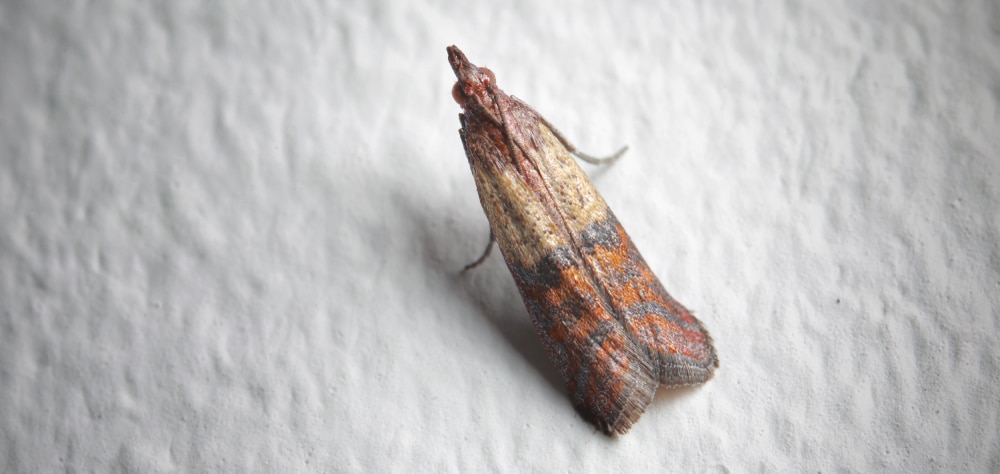
While seeing a moth or two around the house isn’t cause for alarm, when Indian meal moths (also called pantry moths) make a home in your kitchen, it can be troublesome. Indian meal moths are one of the most common pests in kitchens and pantries because they feed on standard pantry items like nuts, grains, and cocoa-based foods. But finding Indian meal moth larvae in your kitchen or in the food you were about to eat is certainly upsetting.
What are Indian meal moths?
Indian meal moths are one of the most common moths in the United States. Their open wingspan is about three-quarters of an inch and they are easy to spot thanks to their distinctive reddish-brown markings with copper luster on their forewings. Like most moths, Indian meal moths are active at night and attracted to light. The eggs of pantry moths are off-white, oval, and very small, nearly impossible to see without a microscope. The larvae turn a yellow, green, or pink hue with a brown head capsule and they spin webs as they grow, leaving behind silken threads where they crawl.

What are pantry moths most attracted to?
Flour, dry pasta, cereals, grains, bread, spices, and other dry, processed snacks are all examples of what Indian meal moths eat. Their sense of smell leads them to food sources. They often show up in homes through infested products but can enter through windows, openings, or vents. Indian meal moths don’t eat clothes or fabrics, but instead prefer grains and similar dry food products.
Are Indian meal moths harmful?
Thankfully, Indian meal moths are not dangerous pests. They don’t bite or sting and aren’t known for causing health issues, diseases, parasites, or pathogens in people or common household pets. The biggest risk they pose is contaminating your food sources and causing you to throw out stored food and goods.
Do pantry moths fly around the house?
You may see adult pantry moths flying anywhere near a food source. While the kitchen, pantry, and dry storage areas are the most common places you’ll find them, they will travel anywhere for proper nutrients and breeding conditions. You may find them flying in search of other food throughout the home, including bathrooms and bedrooms. If you see Indian meal moth larvae in your bedroom, that likely means there is a source of food nearby that needs elimination.
What’s the lifespan of a pantry moth?
A typical life cycle for an Indian meal moth, from egg to egg, can typically be from 25 to 135 days, with a full range of up to 305 days. Under the right conditions, they can complete the entire life cycle in as little as 28 days, with the potential for approximately seven to nine generations to exist within one year. The pantry moth can survive and reproduce if the temperature within a grain bin or storage area stays above 50 degrees Fahrenheit.
Where do pantry moths lay eggs?
Pantry moths lay their eggs right in their preferred food source. A mature female lays 100 to 400 eggs, either singularly or in groups ranging from 12 to 30. Larvae can begin to hatch anywhere from two to 14 days later, depending on the conditions of the environment. The newly hatched larvae feed on fine materials within the grains.
Signs of an Indian meal moth infestation
The easiest way to spot an Indian meal moth infestation is if you see webbing along the corners of the packages or the product inside. Other signs include an unpleasant odor in flour or cereal products or unusual clumping in grains caused by their sticky secretions. A breeding ground may be nearby if you see several moths in or around your pantry or dry goods storage.
How to get rid of Indian meal moths
First, you’ll want to discard any items that you’ve seen a moth in or that has the larvae or eggs visible. If you find pantry moths in one item in your pantry, take the time to inspect other items to ensure you eliminate all the moths as quickly as possible. If you have any open packages of flour, oats and the like, just throw them out and start over with airtight containers.
While both freezing temperatures and extreme heat can kill the Indian meal moth, because their eggs and newly hatched larvae are difficult to detect, it’s best to toss anything you suspect is infected.
The best Indian meal moth treatment method is to take preventative measures before you develop a problem. Good sanitation practices and air-tight food storage are effective practices to keep pantry moths from reaching their intended food source. When you bring food home from the grocery store, look over the packaging for pink-white larvae. Always immediately throw away infested food. Keep the counters, cabinets, and shelves where you store dry goods clean and free of crumbs or food dust.
Indian meal moth pest control
For lasting peace of mind and a thorough inspection, it’s always best to consult a local pest control company, like Hawx Pest Control. Pantry moths pose a unique problem with microscopic eggs and hard-to-see larvae that can be left behind if you try to rid your pantry on your own. With proven methods, qualified technicians, and the best products and services available, Hawx is the undisputed leader in pest control solutions. Our teams focus on ensuring the highest quality results, leading to a safer and more reliable outcome that addresses current problems and prevents future infestations.
Categories
RELATED POSTS



